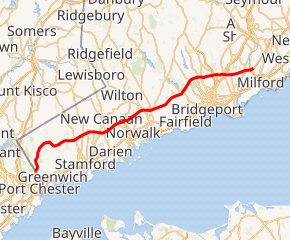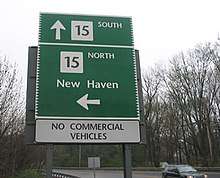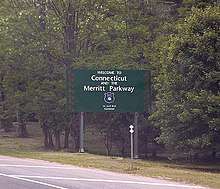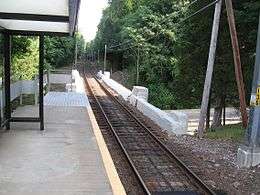Merritt Parkway
The Merritt Parkway (also known locally as "The Merritt") is a limited-access parkway in Fairfield County, Connecticut, with a small section near the northern end in New Haven County. Designed for Connecticut's Gold Coast, the parkway is known for its scenic layout, its uniquely styled signage, and the architecturally elaborate overpasses along the route. As one of the first oldest parkways in the United States, it is designated as a National Scenic Byway and is also listed in the National Register of Historic Places.[5][6] Signed as part of Route 15, it runs from the New York state line in Greenwich, where it serves as the continuation of the Hutchinson River Parkway, to Exit 54 in Milford, where the Wilbur Cross Parkway begins. Facing bitter opposition, the project took six years to build in three different sections, with the Connecticut Department of Transportation constantly requiring additional funding due to the area's high property value. The parkway was named for U.S. Congressman Schuyler Merritt. In 2010 the National Trust for Historic Preservation called the Merritt Parkway one of "America's 11 Most Endangered Historic Places".[7]
| |
|---|---|

Merritt Parkway highlighted in red | |
| Route information | |
| Length | 37.67 mi[1] (60.62 km) |
| Existed | 1938–present |
| Tourist routes | |
| Restrictions | No trucks, buses, trailers, towed vehicles, or vehicles taller than 8 ft (2.4 m)[2][3] |
| Major junctions | |
| South end | |
| North end | |
| Location | |
| Counties | Fairfield, New Haven |
| Highway system | |
| |
Merritt Parkway | |
| Architect | Connecticut Highway Department; et al. |
| Architectural style | Colonial Revival, Classical Revival, Modern Movement |
| NRHP reference No. | 91000410 |
| Added to NRHP | April 17, 1991[4] |
Trucks, buses, trailers, towed vehicles, and all vehicles 8 feet (2.4 meters) tall or taller are not allowed on any part of the parkway due to its low bridges and narrow lanes.
Route description

The Parkway is one of a handful of United States highways listed in the National Register of Historic Places. It is acknowledged for the beauty of the forest that it passes through, as well as the architectural design of its overpasses; at the time of its construction, each bridge was decorated in a unique fashion so that no two bridges on the parkway looked alike.[8] However, newer overpasses used at Exit 39 (US-7) did not maintain this tradition, and as a result, Exit 39 on the parkway is now spanned by several ordinary modern bridges constructed using undecorated concrete on steel I-beams.[9]
The Parkway has two lanes in each direction. Due to its age, it was originally constructed without the merge-lanes, long on-ramps, and long off-ramps that are found on modern limited-access highways. Some entrances have perilously short and/or sharp ramps; some entrances even have stop signs, with no merge lane whatsoever; this leads to some dangerous entrances onto the highway. Most have since been modernized, with the interchange of Route 111 in Trumbull featuring Connecticut's first single point urban interchange (SPUI). The speed limit on the parkway ranges from 45 to 55 mph (70 to 90 km/h). The stretch of road between Exit 42 in Westport and Exit 44 in Fairfield is a very long stretch, roughly five and a half miles long without a single exit, referred to by local traffic reports as "The No Exit Zone"[10] or "No Man's Land".[11] An Exit 43 was planned in the middle of this stretch, but was never built because it would have connected to a northerly extension of the Sherwood Island Connector, which itself was never built to that point.[12]
Vehicles 8 feet (2.4 m) tall or taller in height, weighing 8,000 pounds (3,600 kg) or more, towing a trailer, or containing more than four wheels are not allowed on the parkway. Under extenuating circumstances, however, ConnDOT may issue permits for oversize vehicles to use the Parkway.[2][3]
History



The Merritt Parkway is one of the oldest scenic parkways in the United States.[13] The portion from Greenwich to Norwalk was opened on June 29, 1938. The section from Norwalk to Trumbull was completed in November 1939 and in 1940 was finished to the Housatonic River in Stratford. The parkway was named for U.S. Congressman Schuyler Merritt, who was instrumental in enacting legislation allowing the parkway to be built. The Merritt Parkway is the first leg of what would later become the modern Route 15. Built between 1934 and 1940, the Merritt runs for 37 miles (60 km) from the New York state line in Greenwich to the Housatonic River in Stratford. It was conceived as a way to alleviate congestion on the Boston Post Road (U.S. Route 1) in Fairfield County.[14]
After the parkway fully opened in 1940, it was not uncommon for travelers to stop and picnic along the side of the road.[15] The Merritt Parkway Advisory Commission (later the Merritt Parkway Advisory Committee) decided upon banning horses and buggies, bicycles, pedestrians, billboards, and U-turns while a system of horse trails along the parkway was developed but later abandoned.[16]
To ease objections from county residents who feared an influx of New Yorkers on their roads, in their towns, on their beaches and through their forests, highway planners called on engineers, landscape architects and architects to create a safe and aesthetically pleasing limited access highway—one with exit and entrance ramps, but no intersections—that would not spoil the countryside.[17][18]
The bridges played a prominent role in the design. Architect George L. Dunkelberger designed them all. They reflected the popularity of the Art Deco style, with touches of neo-classical and modern design.[19][20][21] Some of these bridges were constructed by the Works Progress Administration.
Tolls were collected on the parkway at one toll plaza in Greenwich from June 21, 1939, until June 27, 1988. Two additional tolls were also located on the Wilbur Cross Parkway, in Milford and Wallingford. One of the parkway's former toll plazas is now preserved in Stratford's Boothe Memorial Park near Exit 53, complete with still-flashing lights over each toll lane.
In April 2001, a complete reissuance of the parkway's signs was carried out, instituting a uniform white-on-green color scheme, and a sawtooth border.[22][23][24]
Services
Six rest areas/service plazas featuring parking lots, gas stations, and convenience stores were also built along the Merritt so that drivers would not have to exit to refuel. Pairs of plazas are located opposite each other on either side of the parkway in Fairfield (near Exit 46), New Canaan (near Exit 37), and Greenwich (just beyond the CT-NY state line). The northbound-side plaza in Greenwich also houses a Connecticut welcome center. The plazas were originally constructed during the Parkway's days as a tolled highway, but remained even after the tolls were removed in 1988, making the Parkway one of only a few toll-free highways with service plazas along its length. Between 2011 and 2015, all six of the service plazas (along with the four located further north along the Wilbur Cross Parkway) were completely renovated. The renovations preserved the original brick and stone facade of the buildings, but completely redesigned and modernized the interiors. The plazas now include more modern gas pumps, Alltown convenience stores, and a Dunkin' Donuts shop at each location; three of the Merritt's six plazas also include a Subway shop. Prior to the renovations, no fast-food service had previously been available at the plazas. The renovation project was completed during the summer of 2015, when the New Canaan plazas were reopened.
In 2013, electric vehicle (EV) charging stations for Tesla automobiles were added to both the northbound and southbound Greenwich service plazas, with 4 Superchargers installed in each direction. In addition, charging for CHAdeMO-equipped EV's was added to the northbound Greenwich service plaza.The parking/charging stalls are some of the first in the U.S. to be designated "shared use" - EV's may use the stall for up to 45 minutes to charge, or Internal-Combustion Engine (ICE) vehicles may park for up to 15 minutes.[25]
Safety

One of the Merritt's aesthetic features is also a potential danger to its drivers. Trees that line either side of the parkway, and often in the center median, grow branches that cover the roadway, and occasionally fall during severe weather, or with natural aging. Stretches of the parkway also lack guardrails on the right shoulders, creating a risk of tree impact accidents if cars veer off the pavement.
In 2007, after complaints were voiced about the danger of the trees along the parkway, state officials announced they would trim and eliminate some of them more aggressively. A large, seemingly healthy tree fell on a car near Exit 42 in Westport in June 2007, killing a couple from Pelham, New York. On June 23, 2011, a driver was killed in Stamford when a tree fell onto his car.[26]
A state study of fatalities on Connecticut highways showed that from 1985 to 1992, about ten people died every three years in tree-related accidents, although no other state roadway averaged more than one in three years.
The state Department of Transportation commonly sends out work crews twice a year to drive along both sides of the parkway at 5 mph (8 km/h) in search of decrepit trees. Trees that had been scheduled to be cut down in five or ten years would be removed sooner. Some more trees also would be removed, as the shoulder of the parkway is being widened to eight feet in order to give drivers room to pull over.[27]
Following the 2007 and 2011 incidents, the state became more aggressive in closing the parkway in times of severe weather. The parkway was closed during Tropical Storm Irene[28] and the Halloween nor'easter in 2011, and Hurricane Sandy in 2012. With each of those storms, many trees and limbs fell across the parkway. After Sandy, the state began a large effort to remove unhealthy trees, and in the process created much wider clearances between the roadside and forest.[26]
The parkway also has three sharp curves where speed limits are reduced to 45 miles per hour (72 km/h), two in Greenwich and one in Fairfield.
The state has a Merritt Parkway Advisory Committee that meets quarterly.[27]
Future
ConnDOT is currently reviewing plans and holding community meetings over a redesign of the Merritt's interchange with U.S. Route 7 (US 7) and Main Avenue in Norwalk, exits 39 and 40.[29] The US 7 freeway was extended north to Wilton from its previous terminus in the northern part of Norwalk in 1992, passing the Merritt along the way. Due to a lack of funds, a full interchange was not built between the Merritt and US 7, which led to the lack of the important southbound Merritt to southbound US 7 connection. Not long after, ConnDOT and the federal government drew up plans for a three level interchange that provided all connections between Main Avenue, the Merritt, and US 7. Work was supposed to begin on the Main Avenue portion in 2005 and on the US 7 and Merritt portion in 2007. However, local activists filed and won lawsuit in 2006 against ConnDOT and the federal government, alleging that not only was the proposal too expensive, but the plans were rushed and didn't take into account the beauty and historical significance of the parkway. Similar lawsuits were brought on earlier during the construction of the interchanges at Route 8 and Route 25, however, both failed. The lawsuit specifically mentions the flyover ramps between the Merritt and US 7 as a significant issue. ConnDOT and the federal government were forced to redesign their plans, with hopes of construction starting in 2009. Plans soon fell apart, and ConnDOT was forced to temporarily drop the issue.[30] Community outreach started back up in 2017, and ConnDOT is actively drawing up plans as of May 2019 with hopes of starting construction sometime between 2021 and 2024.[31]
Exit list
Like most highways in Connecticut, exits are numbered sequentially, not mile based, though the state is gradually transitioning to milepost-based exit numbers. Exit numbers on the Merritt continue with those of the Hutchinson River Parkway, which formerly ended at 27. More interchanges were since added in New York, so King Street (NY 120A), which travels along the state border, is served by exit 27 on the Merritt and exit 30 on "the Hutch".
| County | Location | mi[1] | km | Exit | Destinations | Notes |
|---|---|---|---|---|---|---|
| Fairfield | Greenwich | 0.00 | 0.00 | – | Continuation into New York; exit numbers continue south along Hutchinson Parkway | |
| 0.05 | 0.080 | 27 | Access to NY 120A south via Hutchinson Parkway exit 30S | |||
| 3.39 | 5.46 | 28 | Round Hill Road | To Greenwich Business District | ||
| 4.16 | 6.69 | 29 | Lake Avenue | |||
| 5.71 | 9.19 | 31 | North Street | To Greenwich Business District | ||
| Stamford | 8.89 | 14.31 | 33 | Den Road | Right-in/right-out interchange | |
| 9.22 | 14.84 | 34 | To Downtown Stamford and University of Connecticut Stamford Campus | |||
| 10.40 | 16.74 | 35 | ||||
| New Canaan | 13.15 | 21.16 | 36 | |||
| 13.89– 14.10 | 22.35– 22.69 | 37 | ||||
| Norwalk | 16.01 | 25.77 | 38 | To Norwalk Community College | ||
| 16.87– 17.31 | 27.15– 27.86 | 39 | Northbound exit and southbound entrance; signed as exits 39A (south) and 39B (north); redesign in proposal stage[29] | |||
| 17.53– 17.63 | 28.21– 28.37 | 40 | Signed as exits 40A (south) and 40B (north); no northbound signage for US 7 | |||
| Westport | 20.73 | 33.36 | 41 | |||
| 21.59 | 34.75 | 42 | ||||
| Fairfield | 26.95 | 43.37 | 44 | To Fairfield Business District and Fairfield University | ||
| 28.58 | 46.00 | 46 | To West Campus of Sacred Heart University, formerly General Electric Headquarters[32] | |||
| Trumbull | 29.31 | 47.17 | 47 | Park Avenue | To University of Bridgeport and Sacred Heart University | |
| 30.37 | 48.88 | 48 | Single-point urban interchange | |||
| 31.64 | 50.92 | 49S | Southbound access to Route 25 south via exit 52; exit 7A on Route 25 north | |||
| 32.69 | 52.61 | 49 49N | Signed as exit 49 southbound, exit 49N northbound; exits 8A & B on Route 25 south | |||
| 32.99 | 53.09 | 50 | Southbound exit and northbound entrance | |||
| 33.51 | 53.93 | 51 | Northbound exit and southbound entrance | |||
| 33.77– 34.57 | 54.35– 55.64 | 52 | Northbound access to Route 8 south via exit 49S; exits 9-10 on Route 8 | |||
| Stratford | 36.54 | 58.81 | 53 | |||
| Housatonic River | 37.53 | 60.40 | Igor I. Sikorsky Memorial Bridge | |||
| New Haven | Milford | 37.67 | 60.62 | 54 | Access via Milford Parkway | |
| – | Continues north as the Wilbur Cross Parkway | |||||
| 1.000 mi = 1.609 km; 1.000 km = 0.621 mi | ||||||
In popular culture
- Willem de Kooning oil-on-canvas painting Merritt Parkway (1959) is owned by the Detroit Institute of Arts.[33][34]
- Lisa Seidenberg, a filmmaker from Westport, produced a documentary film, The Road Taken...The Merritt Parkway (2008).[35]
- The Merritt Parkway is mentioned in J. D. Salinger's short story, "Uncle Wiggily in Connecticut," published in The New Yorker in 1948 and included in his 1953 book, Nine Stories.
- The introduction sequence to the sitcom Who's the Boss briefly featured the parkway at an exit near Westport.
Images
.jpg) Map (western segment)
Map (western segment).jpg) Map (eastern segment)
Map (eastern segment) Talmadge Hill Metro-North station over the Merritt in New Canaan
Talmadge Hill Metro-North station over the Merritt in New Canaan
See also
- Merritt Parkway Bridges
- National Register of Historic Places listings in Fairfield County, Connecticut
- Connecticut Route 15
References
- Connecticut Department of Transportation (2012). "2012 Traffic Volumes, State Maintained Highway Network" (PDF). Connecticut Department of Transportation. Retrieved January 27, 2020.
- "Connecticut Parkways: Vehicles Prohibited from Connecticut Route 15 (Merritt Parkway and Wilbur Cross Parkway) between the New York State Line & I-91 in Meriden, CT and State Route 796 (Milford Parkway)". Connecticut Department of Transportation. January 15, 2020. Archived from the original on March 14, 2020. Retrieved March 14, 2020.
- "What is allowed to travel on the Merritt Parkway?". Connecticut Department of Transportation. Archived from the original on November 3, 2017. Retrieved August 24, 2007.
- "National Register Information System". National Register of Historic Places. National Park Service. January 23, 2007.
- "Connecticut: Fairfield County Historic Places". National Register of Historic Places. Archived from the original on August 17, 2017. Retrieved August 24, 2007.
- Shannahan, John W. (April 17, 1991). "National Register of Historic Places in America". Retrieved March 14, 2020.
National Park Service Certification I, hereby, certify that this property is: entered in the National Register [signed Beth L. Savage] 4-17-91[...]The Merritt Parkway, Connecticut's ALL-YEAR GATEWAY TO NEW ENGLAND, Welcome to our State. We want you to enjoy your stay here and to come again. [signed Raymond E. Baldwin ] Governor
- "America's 11 Most Endangered Historic Places". National Trust for Historic Preservation. Archived from the original on May 22, 2010. Retrieved May 23, 2010.
- Lynn, Catherine; Wigren, Christopher (February 22, 1991). "National Register of Historic Places Registration Form: Merritt Parkway" (PDF). National Park Service. Retrieved February 12, 2015. Photos
- "Steel Structure" (PDF). Connecticut Department of Transportation. Archived (PDF) from the original on February 21, 2017. Retrieved July 12, 2018.
- "Traffic: A Guide to the Pure Chaos of the Merritt Parkway". DimeBrothers. Archived from the original on July 10, 2011. Retrieved February 18, 2008.
- Radde, Bruce (1993). The Merritt Parkway. New Haven, Connecticut: Yale University Press. p. 84. ISBN 0-300-05379-7. Retrieved February 18, 2008.
- Fenster, Jordan (March 26, 2019). "Why is there no Exit 43 on the Merritt Parkway?". The News-Times. Archived from the original on April 6, 2019. Retrieved April 6, 2019.
- "Connecticut Scenic Drives: Merritt Parkway". HowStuffWorks. April 12, 2007. Archived from the original on July 12, 2018. Retrieved July 12, 2018.
- "CT's In A Jam, But More Road Capacity Isn't The Answer". Hartford Courant. Archived from the original on July 12, 2018. Retrieved July 12, 2018.
- Trumbull Historical Society (February 19, 2004). Trumbull. ISBN 978-0-7385-3458-9.
- Radde, Bruce (1993). The Merritt Parkway. New Haven, Connecticut: Yale University Press. p. 83. ISBN 0-300-05379-7.
- "Merritt Parkway Preservation Landscape". Connecticut Department of Transportation. Retrieved March 14, 2020.
- Fazzalaro, James J. (May 17, 2002). Merritt Parkway Traffic Accident Analysis. Connecticut General Assembly Office of Legislative Research. 2002-R-0501. Retrieved March 14, 2020.
- "Local Legacies — The Merritt Parkway". Library of Congress. 2000. Archived from the original on October 4, 2007.
- Roth, Charles R. "The Merritt Parkway: The Queen of All Parkways". Trumbull, Connecticut: Trumbull Historical Society. Archived from the original on October 2, 2007. Retrieved October 4, 2007.
- "A Scenic Roadway that Bridges many Divides". Hartford Courant. Retrieved January 24, 2007.
- "Historical Merritt Parkway Images". Connecticut Department of Transportation. 2016. Retrieved March 14, 2020.
- "Merritt Parkway Signage to be Replaced". Connecticut Department of Transportation. April 13, 2017. Retrieved March 14, 2020.
- Shay, Jim (April 12, 2017). "State plans to replace signs on Merritt Parkway". Connecticut Post. Archived from the original on April 16, 2017. Retrieved March 14, 2020.
- "EV Charging Stations" (PDF). Archived (PDF) from the original on June 5, 2019. Retrieved June 5, 2019.
- Cassidy, Martin B. (December 15, 2012). "State eliminates storm-weakened Merritt trees". Danbury News-Times. Archived from the original on February 26, 2014. Retrieved December 17, 2012.
- Ginocchio, Mark (July 27, 2007). "Merritt trees to face the ax". The Advocate (Norwalk ed.). Stamford, Connecticut. pp. 1, A4.
- "Irene knocks out power, downs trees on approach". WTNH-TV. August 28, 2011. Archived from the original on September 18, 2011. Retrieved September 1, 2011.
- "Route 7/15 Norwalk Project". Archived from the original on March 28, 2019. Retrieved May 22, 2019.
- "The US 7-CT 15 Interchange". Merritparkway.org. Archived from the original on June 5, 2019. Retrieved May 22, 2019.
- Krasselt, Kaitlyn. "DOT Explains Route 7/15 Interchange Project". The Hour. Archived from the original on January 13, 2017. Retrieved May 22, 2019.
- Grice, Jordan (September 14, 2018). "Sacred Heart settling into former GE headquarters". Connecticut Post. Archived from the original on September 13, 2018. Retrieved March 14, 2020.
- Willem de Kooning, Merritt Parkway, 1959 Archived September 23, 2015, at the Wayback Machine, AMICA (Art Museum Images from Cartography Associates) Library.
- Content is a Glimpse: March 1960: Interview with David Sylvester, recorded March 1960 Archived May 18, 2015, at the Wayback Machine, Willem de Kooning Foundation.
- "The Road Taken...The Merritt Parkway". Westport Historical Society. October 6, 2008. Archived from the original on May 18, 2015.
Further reading
- Radde, Bruce (1993). The Merritt Parkway. New Haven, Connecticut: Yale University Press. ISBN 0-300-06877-8.
- Larned, Larry (1998). Traveling the Merritt Parkway. Charleston, S.C.: Arcadia. ISBN 0-7524-0946-8.
All of the following are filed under Fairfield County, CT:
- HAER No. CT-63, "Merritt Parkway, Beginning in Greenwich & running 38 miles to Stratford", 119 photos, 21 measured drawings, 160 data pages, 8 photo caption pages
- HAER No. CT-131, "Merritt Parkway, Greenwich (Northbound) Service Station", 2 photos, 3 data pages, 1 photo caption page
- HAER No. CT-132, "Merritt Parkway, Greenwich (Southbound) Service Station", 2 photos, 3 data pages, 1 photo caption page
- HAER No. CT-133, "Merritt Parkway, (Northbound) New Canaan Service Station", 1 photo, 3 data pages, 1 photo caption page
- HAER No. CT-134, "Merritt Parkway, (Southbound) New Canaan Service Station", 1 photo, 3 data pages, 1 photo caption page
- HAER No. CT-135, "Merritt Parkway, (Southbound) Maintenance Garage", 4 photos, 5 data pages, 1 photo caption page
- HAER No. CT-136, "Merritt Parkway, (Northbound) Fairfield Service Station", 3 photos, 3 data pages, 1 photo caption page
- HAER No. CT-137, "Merritt Parkway, (Southbound) Fairfield Service Station", 2 photos, 3 data pages, 1 photo caption page
- HAER No. CT-138, "Merritt Parkway, Toll Booth, Boothe Memorial Park, Stratford", 1 photo, 1 photo caption page
- HAER No. CT-139, "Merritt Parkway, Visitor's Center, Greenwich", 2 photos, 1 photo caption page
External links
| Wikimedia Commons has media related to Connecticut Route 15. |
| Wikimedia Commons has media related to Merritt Parkway. |

